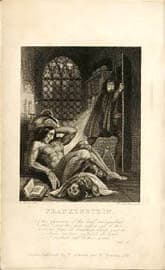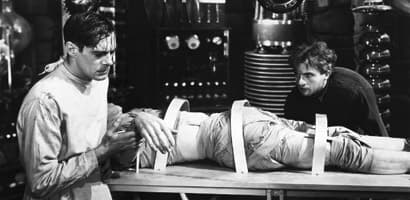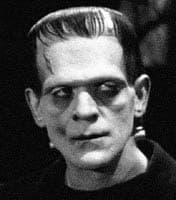Frankenstein
Critique • Text • Frankenstein at the movies
 Frontispiece, first illustrated edition 1831
Frontispiece, first illustrated edition 1831Original title
Frankenstein; or, The Modern Prometheus
First publication
1818
Literary form
Novel
Genre
Literary, science fiction, horror
Writing language
English
Author's country
England
Length
Approx. 78,000 words

Doctor Frankenstein (Colin Clive) and Fritz (Dwight Frye) check their creation in the film that started it all.
It's alive
Frankenstein (1931): Film, 70 minutes; director James Whale; writers John Balderston, others; featuring Boris Karloff, Colin Clive, Edward Van Sloan, Dwight Frye
More than 100 movies about Frankenstein have been produced in various languages. It begins with a 1910 silent movie that runs all of 12 minutes, drastically reducing and revising Mary Shelley's story. You can find restored and colorized versions online.
But the first version that has to be considered classic is the one that gave us the flat-topped, big-headed monster with the neck bolts, padded shoulders, and the vocabulary consisting of two words: "Arrrrr" and "ARRRRRR!". That's the 1931 Boris Karloff Frankenstein, of course.
I know, I know, Frankenstein is the name of the man who creates the monster, not the monster itself.
But millions of kids around the world (and more than a few adults) who once screamed "It's Frankenstein!" in movie theatres were enjoying their fear of a monster, not of a lab-coated doctor. This is thanks to Karloff's portrayal of the creature that stole the movie named Frankenstein and established the association in the public mind for at least the rest of the century.
Poor Colin Clive, who played the doctor with outlandish panache, is known only as the character who screamed "It's alive! It's alive!" in the 1931 film and again in 1935's Bride of Frankenstein.
Clive did however originate a dubiously iconic figure of his own in these two films—the mad scientist—who would also become a Hollywood staple.
Here come Ol' Flat-top
That famous first Frankenstein movie from Universal Studios is not really a direct adaptation of Mary Shelley's novel. It was actually based on a stage play by Peggy Webling, one of several playwrights who had tried to adapt Shelley's vision for the theatre since the novel was published in 1818.
The novel's bookends—Frankenstein chasing his monster through the Arctic, getting picked up at sea by an explorer to whom he tells his tale—are gone. Instead of medical student Victor Frankenstein building the monster in an urban loft, the full-fledged scientist, now named Henry, works in a rural castle in darkest Bavaria where he uses incredibly huge and sophisticated equipment, powered by lightning flashes, to animate his creation. (Those "bolts" on the monster's head are supposed to be electrodes.)
This actually improves on the novel in my view. I never quite accepted Shelley's idea that the creature was stitched together in a small room and then just got up and walked away.
And the film is so much more dramatic. The whole animation sequence, directed by James Whale, has seldom been equalled as a cinematic experience. It's impossible now to imagine how it must have thrilled audiences in the 1930s, ages before computer graphics took over Hollywood special effects.
Other plot points from the novel are also left out or changed. The monster doesn't learn to speak (another improvement on Shelley). He kills not out of an innate savagery but because he is misunderstood.
Without dialogue and through mounds of makeup, Karloff conveys a confused, well-intentioned but ultimately doomed creature. While the book concerns a being without a civilizing soul and condemns the arrogance of man for trying to create life, the film to a surprising degree enlists our sympathy on the side of the creature and condemns those ignorant people who attack it out of fear.
In addition to the "monster" and the "mad scientist", one other iconic horror-film figure is created in Frankenstein: the sycophantic hunchbacked lab assistant. Here he's named Fritz, portrayed with panache by Dwight Frye, who had been so memorable as the insane Renfeld in Dracula and who would appear as minor characters in subsequent Frankenstein films and other horror flicks.
— Eric
Critique • Text • Frankenstein at the movies
1931, 1935, 1939, 1942–1948, 1957, 1958–1970, 1973–1996, 1994, 2014


